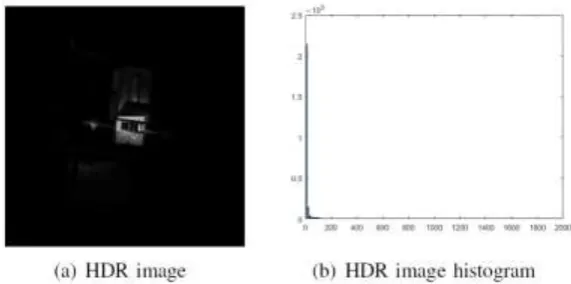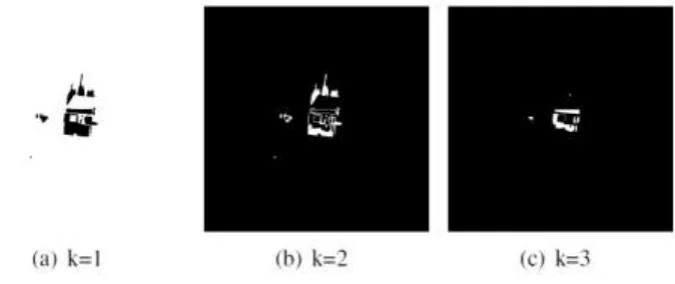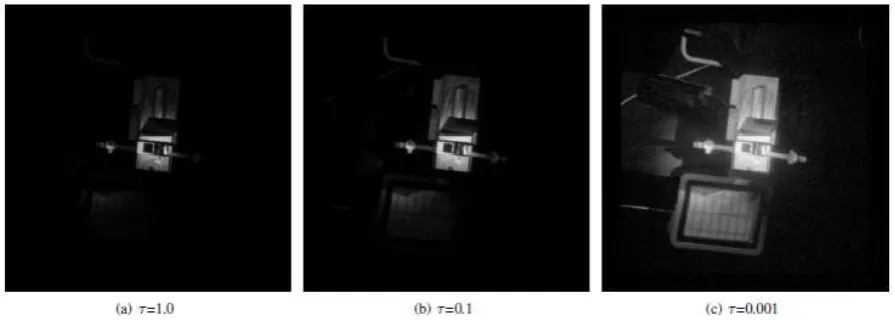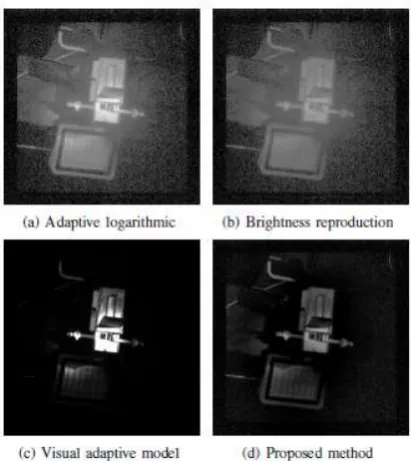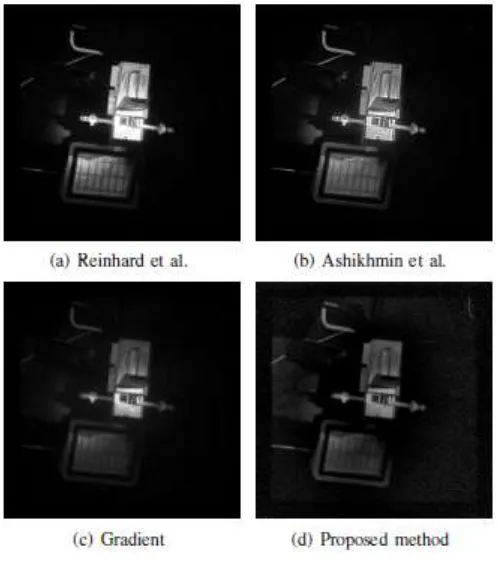2017 2nd International Conference on Software, Multimedia and Communication Engineering (SMCE 2017) ISBN: 978-1-60595-458-5
A Novel Tone Mapping Method for Space High Dynamic Range Images
Yue-pei LI
1,2,*, Jun-suo ZHAO
2and Feng-ge WU
21
University of Chinese Academy of Science, Beijing 100190, China
2
Science and Technology on Integrated Information System Laboratory, Institute of Software, Chinese Academy of Science, Beijing, China
*Corresponding author
Keywords: HDR, High dynamic range, Tone mapping, Space image, Image process.
Abstract. Space high dynamic range imaging is a useful and powerful technique to obtain HDR images. However, HDR images, which carry the whole space scene information, cannot be displayed on most common devices because of the high dynamic range. In this paper, we proposed a novel method that takes advantage of both local and global tone mapping operators. And in the comparison with previous tone mapping operators, we find proposed method is balanced at performance and computational efficiency, which is appropriate for our phonesat with strong computing power.
Introduction
Space High Dynamic Range (HDR) imaging has become an increasingly hot issue today as the number of lunched satellites, especially Cubesats, become bigger and bigger. Fortunately, several interesting and powerful HDR image capture methods have been developed to obtain HDR images in the last decade. HDR images captured by these methods, which records the physically-real light values, is often not able to be displayed on the most common display devices natively. Because the entry level monitors have a low contrast ratio of only around 200:1, which is much lower than the dynamic range of space scene. Thus the tone mapping operation is necessary.
Tone mapping operator adapts the dynamic range of HDR content to suit the lower dynamic range available on a given display and this reduction of the range attempts to keep some characteristics of the original content such as local and global contras, details, etc. Furthermore, the perception of the tone mapped image should match the perception of the real-world scene (see Figure 1). Tone mapping operators (TMOs) can be classified in two broad categories: global and local tone mapping operators. The global mapping operators map all pixels with the same operator. They have one distinct advantage of computationally efficiency. Many of them may be executed in real time. Because they use monotonic mapping functions, global operators are generally much faster than any of the other classes of operators. On the other hand, if the dynamic range of an image is extremely high, the global tone mapping operators may not always preserve visibility as well as other operators. Local operators by compressing each pixel according to its luminance value as well as to the luminance values of a set of neighboring pixels can represent wide dynamic range images more successfully than global operators. However, they will cost more execution time because of the complexity of algorithm.
Figure 1. Perceptual match between a real-world scene and tone mapped image.
Related Work
Global Tone Mapping
With global operators, the same operator that applied to all pixels should be well designed. To obtain a tone mapped image preserving global contrast well, many algorithms have been proposed. Drago et al. [2] presented an operator based on logarithmic mapping. A brightness reproduction method was proposed in [11] and revised in [10] by Tumblin et al. Ferwerda et al. [6] presented a tone mapping operator based on psychophysical experiments, which was subsequently extended by Durand and Dorsey [4].
Local Tone mapping
Local operators improve the quality of the tone mapped image over global operators by attempting to reproduce both the local and the global contrast. To achieve this goal, the intensity values of the neighboring pixels of the pixel being mapped was taken into account. A local operator based on photographic principles was presented by Reinhard et al. [9]. Meylan et al. [8] have proposed a Retinex-based adaptive filter to be applied in the context of tone mapping. A different approach was proposed by Fattal et al. [5], where gradients of the image are modified to achieve range compression.
Problem Formulation
For the high dynamic range images we captured at the ground environment simulation, there is only a small part of the image that have high brightness. Large part of image is dark areas or even utterly black background. To apply a monotonous global operator on the whole image is not wise. Figure 2 shows this situation. So we found the idea to segment the area of input image. Since the dynamic range varies a lot from different high dynamic range images, it is hard to determine a constant boundary to segment target out from background. K-means cluster is introduced to handle this problem.
[image:2.595.156.442.632.774.2]Another problem is the seams appeared at the combination of different segments with different tone mapping operations. Seam problem or holes are often appeared at the mosaic images or fusions of different images. It will destroy the integrity of the images and affect the global contrast. If the seam problem is not effectively dealt with, it will cause image distortion of shading.
Moreover, the image we captured on the ground suffers from the noise problem, which is even more common in space imaging. An operator magnify the dark area too much to get details will magnify noise at the same time. So the proposed method should have resistance to the noise.
Proposed Method
Gaussian Pyramid and Laplacian Pyramid
Our approach is based on standard image pyramids, whose construction we summarize briefly. For more detail, see [1]. Given an image I, its Gaussian pyramid is a set of images Gl called levels, representing progressively lower resolution versions of the image, in which high-frequency details progressively disappear. In the Gaussian pyramid, the bottom-most level is the original image,
0
G I , and Gl1downsample G( l) is a low pass version of Gl with half the width and height. The
filtering and decimation process is iterated n times, typically until the level Gn has only a few pixels.
The Laplacian Pyramid is a closely related construct, whose levels Ll represent details at different spatial scales, decomposing the image into roughly separate frequency bands. Levels of the Laplacian pyramid are defined by the details that distinguish successive levels of the Gaussian pyramid,Ll Glupsample G( l1), where upsample( ) is an operator that doubles the image sized in each dimension using a smooth kernel. The top-most level of the Laplacian pyramid, also called the residual, is defined as LnGn and corresponds to a tiny version of the image. A Laplacian pyramid
can be collapsed to reconstruct the original image by recursively applying Gl Ll upsample G( l1)
until G0 I is recovered.
Based on the introduction above, we first build Gaussian pyramid for input HDR image. For it offers the variety scales of images, Gaussian pyramid is often used in image process. A k-means cluster on the full-scale HDR image, which is 512512, will cost too much time, while on the contrary, a k-means cluster on a small-scale HDR image will loss its function. So we choose a median level, which is the 4th level, of Gaussian pyramid and the scale is 6464. In this way, the data set of k-means cluster has been reduced and the algorithm would be accelerated.
K-means Segmentation
To divide the radiance range properly, the concept of clustering can be utilized, as used for exploratory data analysis. There have been numerous clustering approaches, such as hierarchical clustering, partitional clustering and spectral clustering. Among them, k-means clustering is one of the most popular and widely studied clustering methods for points in Euclidean space. K-means clustering aims to partition n observations (input data) into k sets (k<n) S{S ,S ,... ,S1 2 k} in which each observation (input data) belongs to the cluster with the nearest mean. Given a set of observations (input data) (x ,x ,...,x1 2 n), where each observation is a d-dimension real vector, the goal of clustering is to find those k means (centroid) vectors (c ,....,c1 k) and provide the cluster assignment yi of each
point xi in the set. The equation is as follows:
2
1
|| ||
i j k
i j j x S
min x c
(1)k beyond necessity makes the algorithm inefficient. While a smaller k value than necessary, on the other hand, does not preserve local details of an image. Considering the context of common space target images, we find that our image could be divided into 3 segments naturally: the part of a target that is directly exposed to the sun, the dark part of the target and the black background. So k = 3 would be a relative well choice in the tone mapping of space target images.
Figure 3. Three weight map of every segment.
After we do k-means cluster on the 4th level Gaussian pyramid of HDR image, the result could be used to determine the segmentation on the input HDR image. For every 64 pixels in the input HDR image is mapped into one pixel in 4th level pyramid. They all have the same sort of classification. This map is represented in Eq. (2).
1 4
,
, 8 8
{ }, where { }
i j i i
Z C k Z C k (2)
Where Zij1 is the first level of Gaussian pyramid and also the input HDR image. As to process each
segment respectively, a weight map is introduced to represent each segments. The weight map is defined as:
,
1, { }
0,
ij ij k
where Z C k W
others
(3) The result of the segment is shown in Figure 3.
Tone Mapping
Through the above process, the divided k regions are applied to different global tone mapping operators respectively. The global tone mapping operator is a logarithmic tone mapping with a different user parameters. The logarithmic tone mapping operator is one of the most popular global tone mapping operators because it has straightforward calculations and considerable visual performance. Logarithmic tone-mapping operator is:
( ) ( )
( ) ( )
( ) ( )
min
max min min
max min
log I log I
D I D D D
log I log I
(4)
Where Imin and Imax are the minimum and maximum luminance of the scene, Dmax and Dmin are
We proposed an approach to automatically and easily set a offset . This method is motivated by the fact that a centroid of region is the mean brightness value of the region.
Denoting Ci as the centroid of a i-th cluster (i<k)
1 2
{C , C ,..., C }k
C (5) We determine the offset with equation below:
i Ci
[image:5.595.77.525.217.377.2] (6) Where is chosen as 0.01 heuristically.
Figure 4. Tone mapped images with different .
Blending
After we get the tone mapped images with different $\tau$ values, the resulting image R can then be obtained by a weighted blending of the input images:
, ,
1
N
ij ij k ij k k
R W I
(7)with Ik the logic of k-th segment. Unfortunately, just applying Eq. (7) produces an unsatisfactory
result. Disturbing seams appear at the border of each segmentation. To address the seam problem, we use a technique proposed by Mertens et al. in [7], which is first inspired by [1]. It is originally to fuse several images with different exposures. We use it to achieve seamless blending of our tone mapped images. First, the images are decomposed into a Laplacian pyramid, which basically contains band-pass filtered versions at different scales [1]. Blending is then carried out for each level separately. Let the l-th level in a Laplacian pyramid of an image A be defined as L{R}l, and G{B}l for a Gaussian pyramid of image B. Then, we blend the coefficients in a similar fashion to Eq. (7)
3
, ,
1
{ }lij { }lij k { }lij k
k
L R G W L I
(8)each level l of the resulting Laplacian pyramid is computed as a weighted average of the original Laplacian decompositions for level l, with the l-th level of Gaussian pyramid of the weight map serving as the weights. Finally, the pyramid L{R}l is collapsed to obtain R.
Main Process
logarithmic tone mapping operators that have different values. Finally, blend all tone mapped segments with weight map Gaussian pyramid and Laplacian pyramid. The process was shown below:
1.Build Gaussian pyramid and Laplacian pyramid of HDR image
2.Segment image on the 4-th level of Gaussian pyramid with k-means cluster. 3.Make weight map for each segment and build Gaussian pyramid
4.Tone map each segment with logical TMO
5.Blend each tone mapped segment with the weight map use Laplacian pyramid
Results
Computational Efficiency
[image:6.595.150.445.288.390.2]In order to test the efficiency of our tone-mapping operator, we have compared a computation time of our algorithm with that of previous tone mapping algorithms on many high dynamic range images. All experiments are performed with Matlab on Intel core2 i3 CPU 2.40Ghz and 4GB RAM.
Table 1. Execution Time of Different Tone Map Method.
Tone Map Method Time(sec)
Global Tone Map
Adaptive Logarithmic 0.15
Brightness Reproduction 0.21 Visual Adaptive Model 0.32
Local Tone Map
Reinhard 0.85
Ashikhmin 0.52
Gradient 1.42
Proposed Method 0.39
Seven method are compared for performance evaluation: adaptive logarithmic, brightness reproduction, visual adaptive mode, reinhard, retinex, gradient and the proposed algorithm. Among them, adaptive logarithmic, brightness reproduction, visual adaptive mode are global operators. And reinhard, ashikhmin, gradient are local operators.
Table 1 summarizes our experiment results. The proposed tone-mapping operator is faster than all the local operators, and it is about 4 times faster than gradient method. When compared with global operators, it has acceptable computation increments. It is only a little slower than visual adaptive model.
[image:6.595.195.401.537.768.2]Compare Proposed Tone Mapping Operator with Other Tone Mapping Operators
The assessment of tone-mapping operator is an important research topic. However, it is difficult to determine the superiority of tone-mapping operators using a quantitative formula. Thus, we use human observers and psychophysical experimentation to evaluate our algorithm. We heuristically choose several parameters of our algorithm to improve a subjective quality.
[image:7.595.172.421.273.557.2]Figure 5 shows our results and the comparation with three global operators. From the picture, we can know that both adaptive logarithmic and brightness reproduction introduced noise to the tone mapped images. When the details of dark region in the image are magnified by algorithms, the noise is magnified at the same time. While visual adaptive model ignore the dark region of the image to avoid the effects of noise, but it lose too much information, which is not what we want. So none of the three global operators can obtain a satisfactory result. The proposed method preserve details from both dark regions and bright regions, and it suppresses the noise at the same time. The proposed method result is relevant satisfactory compared with other global operators.
Figure 6. Local.
Figure 6 shows the comparison between our results and the ones from other local operators. Our result retains the dark details, just as other local operators. Besides, our results cost shorter execution times than other local operators.
Summary
In this paper, we present a novel tone mapping operator for space high dynamic range images. It is based on the segmentation using k-means cluster. Besides, we invite Gaussian pyramid too accelerate the speed of k-means on the dataset and we also invite Laplacian pyramid to avoid seams when we blend the segments of the input images.
Acknowledgement
References
[1] Burt, P. and Adelson, E., 1983. The Laplacian Pyramid as a Compact Image Code. Readings in Computer Vision 31, 4, 671-679.
[2] Drago, F., Myszkowski, K., Annen, T., and Chiba, N., 2003. Adaptive Logarithmic Mapping For Displaying High Contrast Scenes. Computer Graphics Forum 22, 3, 419-426.
[3] Duan, J., Bressan, M., Dance, C., and Qiu, G., 2010. Tone-mapping high dynamic range images by novel histogram adjustment. Pattern Recognition 43, 5, 1847-1862.
[4] Durand, F. and Dorsey, J., 2000. Interactive Tone Mapping. In Eurographics Workshop on Rendering Techniques 2000, Brno, Czech Republic, June, 219-230.
[5] Fattal, R., Lischinski, D., and Werman, M., 2002. Gradient Domain High Dynamic Range Compression. ACM Transactions on Graphics 21, 3, 249-256.
[6] Ferwerda, J.A., Pattanaik, S.N., Shirley, P., and Greenberg, D.P., 1996. A model of visual adaptation for realistic image synthesis. In Conference on Computer Graphics and Interactive Techniques, 249-258.
[7] Mertens, T., Kautz, J., and Reeth, F.V., 2007. Exposure Fusion. In Conference on Computer Graphics & Applications, 382-390.
[8] Meylan, L. and Susstrunk, S., 2006. High dynamic range image rendering with a retinex-based adaptive filter. IEEE Transactions on Image Processing A Publication of the IEEE Signal Processing Society 15, 9, 2820.
[9] Reinhard, E., Stark, M., Shirley, P., and Ferwerda, J., 2002. Photographic tone reproduction for digital images. ACM Transactions on Graphics 21, 3, 267-276.
[10] Tumblin, J., Hodgins, J.K., and Guenter, B.K., 1999. Two methods for display of high contrast images. ACM Transactions on Graphics 18, 1, 56-94.
